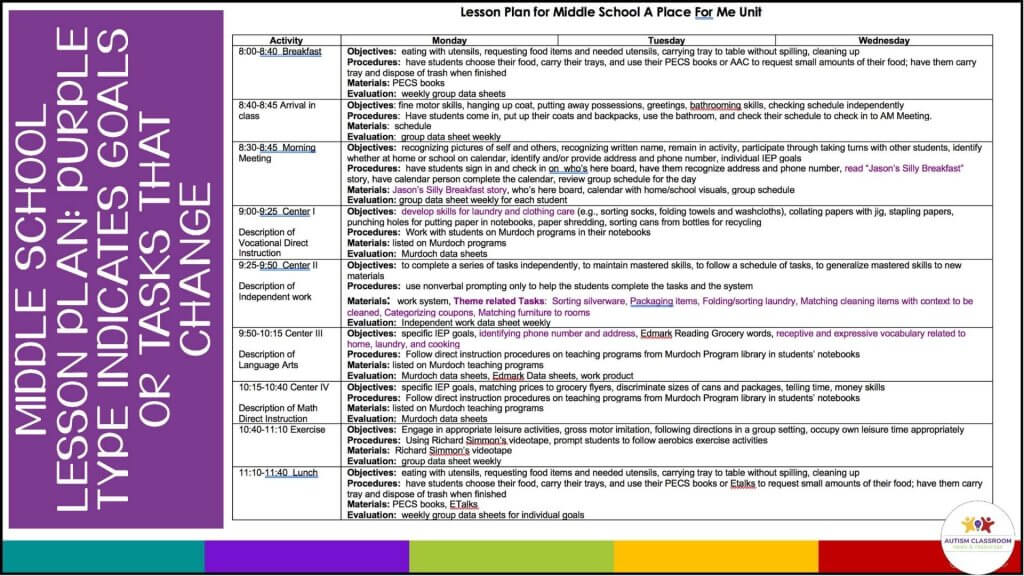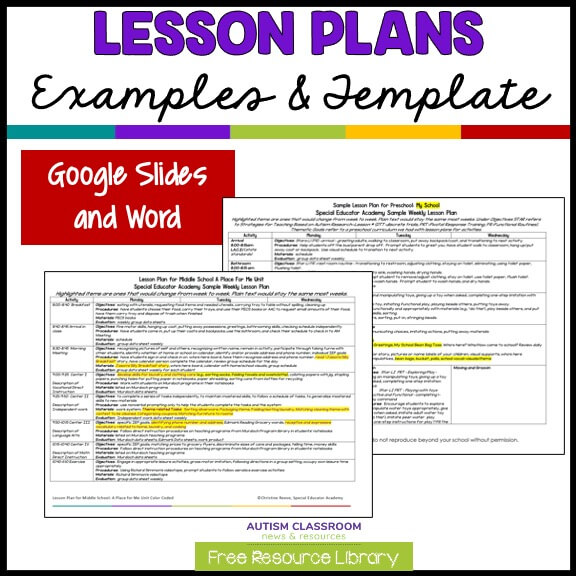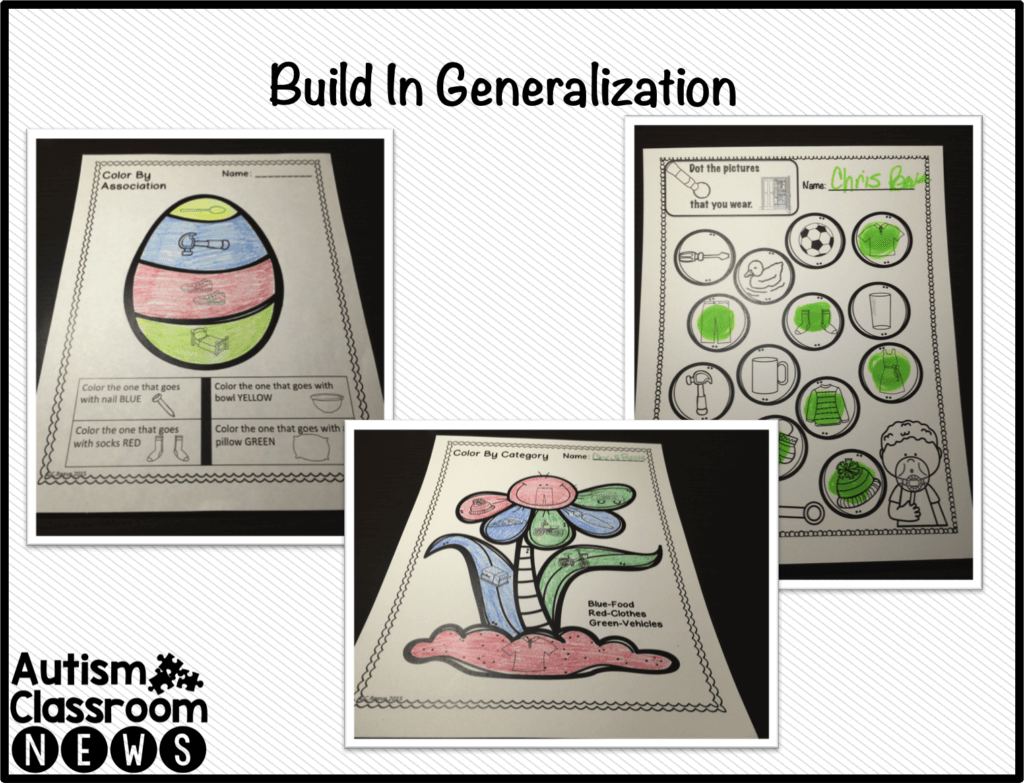I know we all really struggle with special ed lesson plans in our autism classrooms. It’s probably one of the most common questions I get. In addition, I took a poll on Instagram and Facebook, and the vast majority of you said that you weren’t happy with your lesson planning systems.
Table of Contents
I for one like lesson plans. Don’t get me wrong…I hate writing them just as much as anyone else. But I’ve seen what happens when we don’t think we need them.
Why Do We Need Special Ed Lesson Plans?
I know there are many out there who think we don’t need autism lesson plan activities in special education. Many teachers think that the IEPs will drive the lesson plans for each student. Or that every student is so individualized that lesson plans don’t make sense. Read on for my take on why lesson planning is critical.
But in reality we need lesson plans in our special education rooms for a variety of reasons.
- Lesson planning assures that we cover the areas of curriculum we need to review.
- Lesson plans offer proof that skills were taught, on what day, and how they were addressed. This can be critical in due process situations and during IEPs.
- Special ed lesson plans should integrate curriculum (or alternate curriculum) with the IEPs. In other words, the IEP is not the lesson plan. Something the student should work on for her grade level might not be on the IEP if it’s not an area of weakness for her.
- Writing special ed lesson plans also lead us to think about HOW we are teaching skills (more on that in the next section).
- Lesson plans communicate to all the staff who work with your students what is being taught, with what materials and in what context. Without that, we are depending on being able to give them a quick verbal run-down…without assuring they know the goal of what we are trying to address in the activity.
Questions to Ask About Your Lesson Plans
![Lesson Planning in the Autism and Special Education Classroom: How to Make it a Success. With a free download. [picture of a desk with lesson plans]](https://autismclassroomresources.com/wp-content/uploads/2016/09/Lesson-Planning-in-the-Autism-Classroom-1-683x1024.png)
Look at your special ed lesson plans and ask these questions:
- Are the materials teaching the skill I intended?
- Have I differentiated group activities for all the students to participate?
- Can the student generalize the skills I taught?
- Do the paraprofessionals know what the lessons are?
- Do the paras know the objectives we are trying to teach with the lessons?
- Can visitors and families to the classroom understand what the lesson objectives are?
- What other questions should be added?
For all of these reasons, I would say that we DO need special ed lesson plans in the classroom. And they probably will be more detailed than those in a general education classroom because you need more information.
But, you can create lesson plans that are manageable.
And yes you can still communicate the information that the staff need to know. Here are some tips for doing that along with my system for doing it.
Tips for Creating Manageable Special Ed Lesson Plans
1: Create or Use a Template
You may work in a school in which the principal requires lesson plans to be turned in. If so, determine if the format will work for your classroom. If not, ask the principal if you can use a different format and show her what you would like to use.
It’s OK to advocate for your classroom so you aren’t doing double work. Your needs in a special education classroom (or even as support staff for students in the general education classroom) are different.
If you don’t have a required template, create one or grab the free ones at the end of this post. I’m including a couple examples here so you can download them and modify them as you want. There are 2 primary things I like about them.
- They state what the activity is, the materials (so the paras know what to get out) and the objectives. This way everyone knows what skills are being targeted within the lesson. So, the para knows that she shouldn’t give all the materials to the students if an objective is to practice requesting.
- Once you complete them and refine them, many of the activities’ information stays the same. So you just have to fill in the parts that change. For instance, your objectives for morning meeting may not change for much of the year, so those would stay the same.
2: Set Up a Regular Time to Write Your Plans
If you use the free lesson plan template below, once you get it it set up, you will just need to change the parts from week to week that change, like the individual activities and materials. In the downloadable example for preschool I’ve highlighted the parts that would change. So, they won’t take a ton of time.
Even though it shouldn’t be time consuming, it helps to setup an established time to write your lesson plans. You could write them each week, every other week or once a month you could batch them for the month.

3. Remember That You Can Repeat Them
If you are teaching the same lessons on a regular basis, don’t feel like you have to write totally new plans. You’ll see in the examples in the free download that there is a lot of repetition. Special Ed lesson plans are going to have a lot of repetition. Particularly if you teach in a self-contained classroom.
Our students need repetition and consistency. It’s ok to do 1 book for a week (or even 2) in morning meeting if your students are still engaged. You can emphasize different lessons using that same book, giving students some routine.
So my last tip is that it’s OK to have repetitive lesson plans.
4. Make Sure Chosen Materials Teach the Right Skills
Our students can get really misled by the wrong cues. We need to make sure we choose materials that focus their attention on the parts we want them to focus on. I’ve written several posts that touch on this topic. 6 Considerations in Choosing and Preparing Materials for Discrete Trials covers this issue. In addition, 2 Mistakes to Avoid When Using Commercial Products in Structured Work Systems focuses on how to identify problems with materials and provide possible fixes. By including materials in your lesson plans, you assure that the rest of the staff is using the materials you intend for the activity.
5. Create Age-Respectful / Developmentally Appropriate Autism Lesson Plan Activities
I’ve written a number of posts on this issue in part because it’s something I feel passionate about. I like Teaching Learners with Multiple Needs’s take on it being age-respectful and it’s a tricky issue. However, I feel strongly that when you choose materials for instruction, we need to present materials that are age-appropriate. But they obviously also have to meet the developmental level of the students. Here are some ideas to help with what can sometimes be a tricky issue.

- Promoting Engagement Using Age-Appropriate Materials in Middle and High School Special Education Groups
- Functional Vocabulary for Adolescents
- Vocabulary: Make it Engaging AND Age Appropriate
- Creating Teaching Materials: Back to School Setting Up Classrooms for Students with Autism
6. Choose Materials and Lessons that Promote Generalization
Students with autism, and really many students in special education, have difficulty learning skills in a broad way. This impacts their ability to apply their skills across environments, people and materials. Many people think that because we often work on the same skills for long periods of time, we can use fewer materials than other classrooms. However, in reality, it is exactly the opposite. To promote generalization, provide repetition, and keep engagement high, you need LOTS and LOTS and LOTS of stuff.
# 6 in this post focuses on generalization and the need to use lots of different presentations of materials.
5 Ways to Practice Applying Color Concepts for Generalization has ideas for promoting generalization with different types of materials.
Wrapping Up
So to wrap it up, there is obviously a lot to think about when creating autism lesson plans activities in the special education classroom. However, with a good lesson plan template you can plan it all out and assure consistent instruction across the room.
Good lesson planning means that you are pulling information from the students’ Teaching Implementation Plans and embedding them into the scheduled activity. But it also allows for changing out materials, thematic lessons, seasonal activities, etc. all while using the same classroom and lesson plan structure.
Looking for more ideas for lesson planning? Come check us out in the Special Educator Academy. We have a workshop all about them and how to make them workable.
Download Free Special Ed Lesson Plans- Examples and Templates
sign up for free tips each week in your inbox and Grab free sample lesson plans plus free lesson plan templates from the resource library

Included in this set are a preschool lesson plan example, a middle school special education classroom example, and a template that could be used for any age,
The preschool could easily be adapted for elementary, and the middle school can easily be used for high school.






![Summer resources to help survive the end of the year in special education [picture-interactive books with summer themes]](https://autismclassroomresources.com/wp-content/uploads/2018/05/SUMMER-RESOURCES-ROUNDUP-FEATURE-8528-768x768.jpg)

